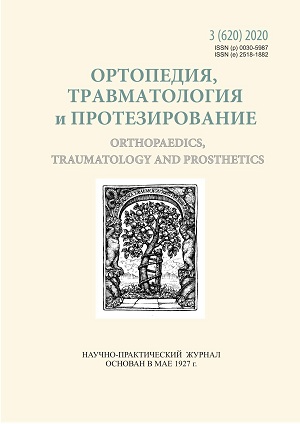Helal osteotomy at surgical treatment of metatarsalgia
DOI:
https://doi.org/10.15674/0030-59872020367-71Keywords:
metatarsalgia, hallux valgus, Helal osteotomyAbstract
Treatment of metatarsalgia in patients with hallux valgus deformity is one of orthopedic problem. It is known about a significant role in the relationship of the length of the metatarsal feet bones and biomechanical metatarsalgia. A number of surgeries have been proposed, including Helal osteotomy, which consists mainly in the posterior displacement of the metatarsal head and it shows good results. Objective: to study the results of surgical treatment of metatarsalgia caused by biomechanical disorders in patients with hallux valgus deformity with corrective Helal osteotomy. Methods: the study is based on the surgical treatment of 114 (179 feet) patients with hallux valgus deformity. Among them, metatarsalgia was found in 32 (17.9 %) of cases. For its treatment corrective osteotomy of the metatarsal bones was used according to the Helal method with screw fixation. Results: according to the ACFAS scale, the average score improved by 32.5 (from 63.1 points before operations to 95.6 points in followup potsurgery period). In 26 (81.3 %) cases with metatarsalgia the regression of symptoms was determined. Conclusions: in our study the frequency of metatarsalgia caused by biomechanical disorders was 17.9 %. In patients with metatarsalgia in 40.6 % of cases metatarsal parabola had small anatomical shape. Surgical treatment of metatarsalgia caused by biomechanical disorders with Helal osteotomy patients allowed us to get positive results in 81.3 % of cases. Helal osteotomy with screw fixation of metatarsal fragments can be an option for the treatment of metatarsalgia.References
- Besse, J. (2017). Metatarsalgia. Orthopaedics & Traumatology: Surgery & Research, 103(1), S29-S39. doi:10.1016/j.otsr.2016.06.020
- Nguyen, U., Hillstrom, H., Li, W., Dufour, A., Kiel, D., Procter-Gray, E., … Hannan, M. (2010). Factors associated with hallux valgus in a population-based study of older women and men: The mobilize Boston study. Osteoarthritis and Cartilage, 18(1), 41-46. doi:10.1016/j.joca.2009.07.008
- Regnauld, B. (1986). The foot (Technigues Chimgicales du Pied). NY : Springer–Verlag
- Nix, S., Smith, M., & Vicenzino, B. (2010). Prevalence of hallux valgus in the general population: A systematic review and meta-analysis. Journal of Foot and Ankle Research, 3(1). doi:10.1186/1757-1146-3-21
- Vincent, J. (1994). Hallux valgus and forefoot surgery. NY: Churchill Livingstone
- Viladot, A. (1973). Metatarsalgia due to biomechanic alterations of the forefoot. Orthopedic Clinics of North America, 4(1), 165–178
- Magnan, B., Pezzè, L., Rossi, N., & Bartolozzi, P. (2005). Percutaneous distal metatarsal osteotomy for correction of hallux valgus. The Journal of Bone and Joint Surgery-American Volume, 87(6), 1191-1199. doi:10.2106/00004623-200506000-00002
- Lelievre, J. (1981). Pathologie du pied. Paris: Masson
- Maestro, M., Besse, J., Ragusa, M., & Berthonnaud, E. (2003). Forefoot morphotype study and planning method for forefoot osteotomy. Foot and Ankle Clinics, 8(4), 695-710. doi:10.1016/s1083-7515(03)00148-7
- Helal, B. (1975). Metatarsal osteotomy for metatarsalgia. The Journal of Bone and Joint Surgery. British volume, 57-B(2), 187-192. doi:10.1302/0301-620x.57b2.187
- Trnka, H. J., Kabon, B., Zettl, R., Kaider, A., Salzer, M., & Ritschl, P. (1996). Helal metatarsalosteotomy for the treatment of metatarsalgia: a critical analysis of results. Orthopaedics, 19(5), 457–461
- Muller, T., Dereymaecker, G., & Victor, J. (1994). Long-term functional results after the Helal osteotomy. Foot Diseases, 1, 69–77
- Trnka, H., Mühlbauer, M., Zettl, R., Myerson, M. S., & Ritschl, P. (1999). Comparison of the results of the Weil and Helal osteotomies for the treatment of Metatarsalgia secondary to dislocation of the lesser Metatarsophalangeal joints. Foot & Ankle International, 20(2), 72-79. doi:10.1177/107110079902000202
- Protsko, V. G., Zagorodny, N. V., & Taj A. A. (2018). Method for eliminating metatarsalgia and deformity of fingers with transverse flat feet. Russian Federation. Patent 2675455 RU. [in Russian]
- Taj, A. A., Protsko, V. G., Cherevtsov, V. N., & Volkov, A. V. (2017). Comparison of the results of Helal and Weil osteotomies for the treatment of metatarsalgia in secondary dislocation in the metatarsophalangeal joints of the 2nd, 3rd and 4th metatarsal bones. Diary of the Kazan Medical School, 3(17), 54–61. [in Russian]
- Wolf, M. D. (1973). Metatarsal osteotomy for the relief of painful metatarsal callosities. The Journal of Bone & Joint Surgery, 55(8), 1760-1762. doi:10.2106/00004623-197355080-00024
- Barouk, L. S. (2005). The BRT Proximal Metatarsal Osteotomy. Forefoot Reconstruction. Paris: Springer
- Mann, R. A., & Coughlin, M. J. (1999). Adult hallux valgus. Surgery of the foot and ankle. St. Louis: Mosby
- Cook, J. J., Cook, E. A., Rosenblum, B. I., Landsman, A. S., & Roukis, T. S. (2011). Validation of the American College of foot and ankle surgeons scoring scales. The Journal of Foot and Ankle Surgery, 50(4), 420-429. doi:10.1053/j.jfas.2011.03.005
Downloads
How to Cite
Issue
Section
License
Copyright (c) 2020 Dmytro Prozorovskiy, Ruslan Buznytskyi Buznytskyi

This work is licensed under a Creative Commons Attribution 4.0 International License.
The authors retain the right of authorship of their manuscript and pass the journal the right of the first publication of this article, which automatically become available from the date of publication under the terms of Creative Commons Attribution License, which allows others to freely distribute the published manuscript with mandatory linking to authors of the original research and the first publication of this one in this journal.
Authors have the right to enter into a separate supplemental agreement on the additional non-exclusive distribution of manuscript in the form in which it was published by the journal (i.e. to put work in electronic storage of an institution or publish as a part of the book) while maintaining the reference to the first publication of the manuscript in this journal.
The editorial policy of the journal allows authors and encourages manuscript accommodation online (i.e. in storage of an institution or on the personal websites) as before submission of the manuscript to the editorial office, and during its editorial processing because it contributes to productive scientific discussion and positively affects the efficiency and dynamics of the published manuscript citation (see The Effect of Open Access).














